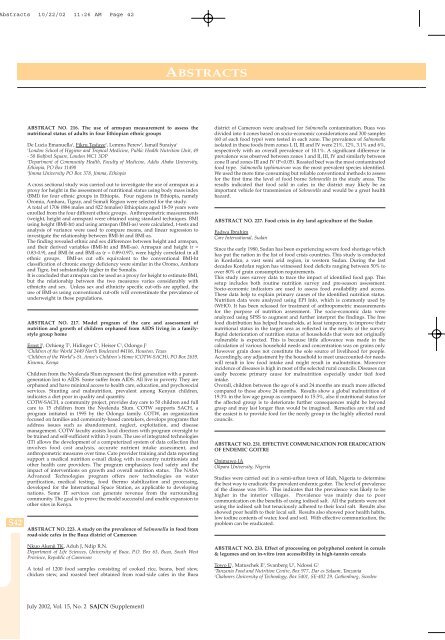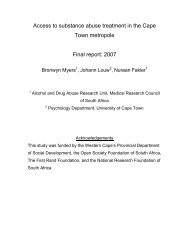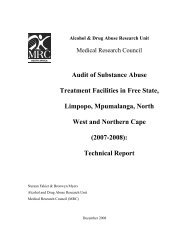Pan-African Conference 21 - 24 July 2002 Inter-Continental Hotel ...
Pan-African Conference 21 - 24 July 2002 Inter-Continental Hotel ...
Pan-African Conference 21 - 24 July 2002 Inter-Continental Hotel ...
You also want an ePaper? Increase the reach of your titles
YUMPU automatically turns print PDFs into web optimized ePapers that Google loves.
Abstracts 10/22/02 11:26 AM Page 42<br />
S42<br />
ABSTRACT NO. <strong>21</strong>6. The use of armspan measurement to assess the<br />
nutritional status of adults in four Ethiopian ethnic groups<br />
De Lucia Emanuella 1 , Fikru Tesfaye 2 , Lemma Ferew 3 , Ismail Suraiya 1<br />
1 London School of Hygiene and Tropical Medicine, Public Health Nutrition Unit, 49<br />
- 50 Bedford Square, London WC1 3DP<br />
2 Department of Community Health, Faculty of Medicine, Addis Ababa University,<br />
Ethiopia, PO Box 11490<br />
3 Jimma University PO Box 378, Jimma, Ethiopia<br />
A cross sectional study was carried out to investigate the use of armspan as a<br />
proxy for height in the assessment of nutritional status using body mass index<br />
(BMI) for four ethnic groups in Ethiopia. Four regions in Ethiopia, namely<br />
Oromia, Amhara, Tigray, and Somali Region were selected for the study.<br />
A total of 1706 (884 males and 822 females) Ethiopians aged 18-59 years were<br />
enrolled from the four different ethnic groups. Anthropometric measurements<br />
(weight, height and armspan) were obtained using standard techniques. BMI<br />
using height (BMI-ht) and using armspan (BMI-as) were calculated, t-tests and<br />
analysis of variance were used to compare means, and linear regression to<br />
investigate the relationship between BMI-ht and BMI-as.<br />
The finding revealed ethnic and sex differences between height and armspan,<br />
and their derived variables (BMI-ht and BMI-as). Armspan and height (r =<br />
0.83-0.9), and BMI-ht and BMI-as (r = 0.89-0.97), were highly correlated in all<br />
ethnic groups. BMI-as cut offs equivalent to the conventional BMI-ht<br />
classification of chronic energy deficiency were similar in the Oromo, Amhara<br />
and Tigre, but substantially higher in the Somalis.<br />
It is concluded that armspan can be used as a proxy for height to estimate BMI,<br />
but the relationship between the two measures varies considerably with<br />
ethnicity and sex. Unless sex and ethnicity specific cut-offs are applied, the<br />
use of BMI-as using conventional cut-offs will overestimate the prevalence of<br />
underweight in these populations.<br />
ABSTRACT NO. <strong>21</strong>7. Model program of the care and assessment of<br />
nutrition and growth of children orphaned from AIDS living in a familystyle<br />
group home<br />
Ernst J1 , Ochieng T2 , Hidinger C1 , Heiser C1 , Odongo J2 1Children of the World <strong>24</strong>49 North Boulevard #4106, Houston, Texas<br />
2Children of the World's-St. Anne's Children's Home (COTW-SACH), PO Box 2639,<br />
Kisumu, Kenya<br />
Children from the Nyalenda Slum represent the first generation with a parentgeneration<br />
lost to AIDS. Some suffer from AIDS. All live in poverty. They are<br />
orphaned and have minimal access to health care, education, and psychosocial<br />
services. Stunting and malnutrition, prevalent among Kenyan children,<br />
indicates a diet poor in quality and quantity.<br />
COTW-SACH, a community project, provides day care to 50 children and full<br />
care to 15 children from the Nyelenda Slum. COTW supports SACH, a<br />
program initiated in 1995 by the Odongo family. COTW, an organization<br />
focused on families and community-based caretakers, develops programs that<br />
address issues such as abandonment, neglect, exploitation, and disease<br />
management. COTW faculty assists local directors with program oversight to<br />
be trained and self-sufficient within 3 years. The use of integrated technologies<br />
(IT) allows the development of a computerized system of data collection that<br />
involves food cost analysis, accurate nutrient intake assessment, and<br />
anthropometric measures over time. Care provider training and data reporting<br />
support a medical nutrition e-mail dialog with in-country nutritionists and<br />
other health care providers. The program emphasizes food safety and the<br />
impact of interventions on growth and overall nutrition status. The NASA<br />
Advanced Technologies program offers new technologies on water<br />
purification, medical testing, food thermo stabilization and processing,<br />
developed for the <strong>Inter</strong>national Space Station, as applicable to developing<br />
nations. Some IT services can generate revenue from the surrounding<br />
community. The goal is to prove the model successful and enable expansion to<br />
other sites in Kenya.<br />
ABSTRACT NO. 223. A study on the prevalence of Salmonella in food from<br />
road-side cafes in the Buea district of Cameroon<br />
Nkuo Akenji TK, Aduh J, Ndip R.N.<br />
Department of Life Sciences, University of Buea, P.O. Box 63, Buea, South West<br />
Province, Republic of Cameroon<br />
A total of 1200 food samples consisting of cooked rice, beans, beef stew,<br />
chicken stew, and roasted beef obtained from road-side cafes in the Buea<br />
<strong>July</strong> <strong>2002</strong>, Vol. 15, No. 2 SAJCN (Supplement)<br />
ABSTRACTS<br />
district of Cameroon were analysed for Salmonella contamination. Buea was<br />
divided into 4 zones based on socio-economic considerations and 300 samples<br />
(60 of each food type) were tested in each zone. The prevalence of Salmonella<br />
isolated in these foods from zones I, II, III and IV were <strong>21</strong>%, 12%, 3.1% and 6%,<br />
respectively with an overall prevalence of 10.1%. A significant difference in<br />
prevalence was observed between zones 1 and II, III, IV and similarly between<br />
zone II and zones III and IV (P

















